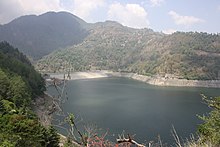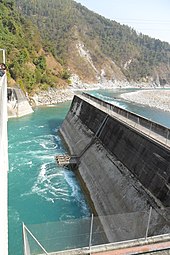Economy of Nepal
[6] Until the mid-20th century Nepal was an isolated pre-industrial society, which entered the modern era in 1951 without schools, hospitals, roads, telecommunications, electric power, industry, or civil service.
The biggest challenges faced by the country in achieving higher economic development are the frequent changes in political leadership, as well as corruption.
It completed its ninth economic development plan in 2002; its currency has been made convertible, and 17 state enterprises have been privatised.
Government priorities over the years have been result in the development of transportation and communication facilities, agriculture, and industry.
Fruits and vegetables (apples, pears, tomatoes, various salad greens, peach, nectarine, potatoes), as well as rice and wheat are the main food crops.
The lowland Terai region produces an agricultural surplus, part of which supplies the food-deficient hill areas.
Although eradication efforts continue, malaria had been controlled in the fertile but previously uninhabitable Terai region in the south.
Kathmandu is linked to India and nearby hill regions by road and an expanding highway network.
[17] In the 2021 Global Hunger Index, Nepal ranks 76th out of the 116 countries with sufficient data to calculate 2021 GHI scores.
Recently, the European Union has become the largest buyer of ready-made garments; fruits and vegetables (mostly apples, pears, tomatoes, various salads, peach, nectarine, potatoes, rice) from Nepal.
Strong export performance, including earnings from tourism, and external aid have helped improve the overall balance of payments and increase international reserves.
The largest hydroelectric plant under consideration is the West Seti Dam (750 MW) storage project dedicated to exports to be built by the private sector.
Over-population is already straining the "carrying capacity" of the middle hill areas, particularly the Kathmandu Valley, resulting in the depletion of forest cover for crops, fuel, and fodder and contributing to erosion and flooding.
Although steep mountain terrain makes exploitation difficult, mineral surveys have found small deposits of limestone, magnesite, zinc, copper, iron, mica, lead, and cobalt.
[27] This is a chart of trend of gross domestic product of Nepal at market prices estimated by the International Monetary Fund and EconStats with figures in millions of Nepali Rupees.
tourism: 9% Population below poverty line: 25.6% (2017/2018)[30] Household income or consumption by percentage share: lowest 10%: 3.2% highest 10%: 29.8% (1995–96) Inflation rate (consumer prices): 4.5% (2017) Labour force: 4 million (2016 est.)
Oil - consumption: 1,600 barrels per day (250 m3/d) 2001 Agriculture - products: Fruits and vegetables, mostly: apples, pears, tomatoes, peaches, nectarines, potatoes, rice, maize, wheat, sugarcane, root crops, milk, and buffalo meat.



